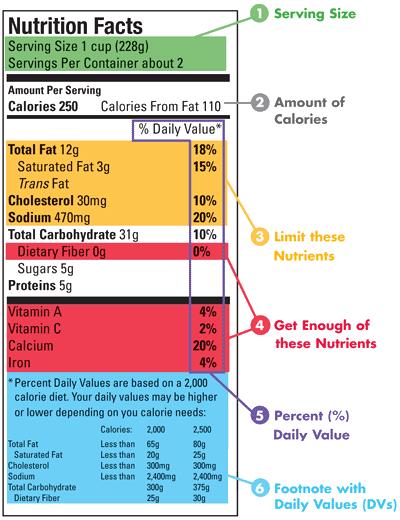Use Nutrition Facts Labels to Choose Heart-Healthy Foods
Whether or not you have a family history of heart disease, it is a good idea to follow a heart-healthy diet. Heart disease is the nation’s No. 1 killer.
 Look for These on the Nutrition Facts Label.
Look for These on the Nutrition Facts Label.
The Food and Drug Administration (FDA) offers the following advice about using the Nutrition Facts label to choose heart-healthy foods:
- Choose foods with:
- Choose foods with less sodium – or salt -, which can increase blood pressure. High blood pressure is a serious risk factor for heart disease.
-
Choose foods with fewer calories and more fiber, especially fiber from:
- fruits
- vegetables
- whole grains.
Fiber may help lower your risk of heart disease.
Know What “Daily Value” Means.
When using the Nutrition Facts label, look for the nutrient’s “% Daily Value.” The general rule is:
- A Daily Value of 20 percent or more means that the food is high in that nutrient. (In food label above, nutrients in red are a good thing, nutrients in yellow are a bad thing!)
- A Daily Value of 5 percent or less means the food is low in the nutrient.
There is no Daily Value for trans fats, so take a look at the total amount of trans fat on the label. The idea is just to keep trans fats as low as possible in your diet.
Be mindful of serving sizes. If you are eating two servings, do not forget to double the percentages!
Recognize Official Heart-Healthy Claims.
You can also look on food labels for official health claims about heart health. These claims have passed muster with the FDA because science has shown that the nutrients mentioned reduced the risk of heart disease. Official heart-healthy claims include:
- “While many factors affect heart disease, diets low in saturated fat and cholesterol may reduce the risk of this disease.”
- “Diets low in sodium may reduce the risk of high blood pressure, a disease associated with many factors.”
-
“Soluble fiber, as part of a diet low in saturated fat and cholesterol, may reduce the risk of heart disease.” Soluble fiber foods include:
- oat bran
- oatmeal
- beans
- peas
- rice bran
- barley
- citrus fruits
- strawberries
- apple pulp.
Consider These Guidelines.
Additional ways for choosing and preparing foods aimed at a healthy heart include:
- Choose lean meat and poultry.
-
Eat fish at least twice a week.
-
Recent research shows that eating oily fish containing omega-3 fatty acids (for example, salmon, trout and herring) may help lower your risk of death from coronary artery disease.
-
Pregnant or breast feeding women should eat at least 12 ounces of fresh fish each week.
-
- When cooking, use liquid oils rather than solid fats as much as possible.
-
Cook using a low-fat method:
- Grill
- Broil
- Bake.
- Avoid foods high in added sugar.
- Choose foods that are high in potassium – unless a health professional has told you to limit the amount of potassium you eat. Potassium acts as a counter-balance to sodium and can help control your blood pressure.
Points to Remember
-
Use information on Nutrition Facts labels to choose foods with:
- less fat less cholesterol
- less added sugars
- less sodium – or salt
- more fiber
- more potassium.
- Choose lean cuts of meat and poultry and use low-fat methods to prepare.
Hope Through Research – You Can Be Part of the Answer!
Many research studies are underway to help us learn about heart disease. Would you like to find out more about being part of this exciting research? Please visit the following links:
- Heart Disease Studies (ClinicalTrials.gov)
References:
- AHA Scientific Statements: Fish Consumption, Fish Oil, Omega-3 Fatty Acids and Cardiovascular Disease
- Eat for a Healthy Heart (FDA)
- Dietary Fats Explained (MedlinePlus)
- Whole Grains and Fiber (American Heart Association)
This article originally appeared in Chow Line, a service of Ohio State University Extension and the Ohio Agricultural Research and Development Center and was adapted for use on NetWellness with permission.
For more information:
Go to the Heart Health health topic.
 Look for These on the Nutrition Facts Label.
Look for These on the Nutrition Facts Label.